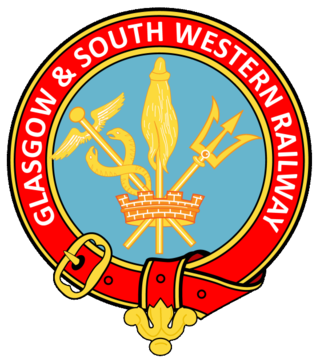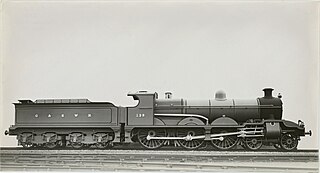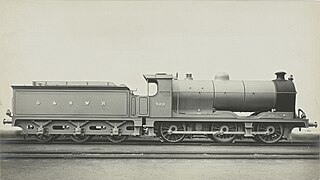
The Glasgow and South Western Railway (G&SWR) was a railway company in Scotland. It served a triangular area of south-west Scotland between Glasgow, Stranraer and Carlisle. It was formed on 28 October 1850 by the merger of two earlier railways, the Glasgow, Paisley, Kilmarnock and Ayr Railway and the Glasgow, Dumfries and Carlisle Railway. Already established in Ayrshire, it consolidated its position there and extended southwards, eventually reaching Stranraer. Its main business was mineral traffic, especially coal, and passengers, but its more southerly territory was very thinly populated and local traffic, passenger and goods, was limited, while operationally parts of its network were difficult.
A number of different numbering and classification schemes were used for the locomotives owned by the London, Midland and Scottish Railway (LMS) and its constituent companies.
The Glasgow, Dumfries and Carlisle Railway was a railway company in Scotland, which constructed the line from near Cumnock to Gretna Junction, forming the route from Glasgow to Carlisle via Dumfries, in association with other lines. Its promoters hoped it would form the only railway between central Scotland and England, but it lost out to rival companies.
The Glasgow and Paisley Joint Railway was the section of railway line between Glasgow Bridge Street railway station and Paisley, in the west of Scotland. It was constructed and operated jointly by two competing railway companies as the stem of their lines to Greenock and Ayr respectively, and it opened in 1840. The Joint Committee, which controlled the line, built a branch to Govan and later to Cessnock Dock, and then Prince's Dock.
The Paisley and Renfrew Railway was an early Scottish railway company that constructed and operated a line between Paisley and the River Clyde at Renfrew Wharf, enabling journeys between Glasgow and Paisley by connecting river boat. The railway was built to the track gauge of 4 ft 6 in on stone block sleepers.

The Glasgow, Paisley, Kilmarnock and Ayr Railway (GPK&AR) was a railway in Scotland that provided train services between Glasgow, Kilmarnock and Ayr. It opened its first line, between Glasgow and Ayr, in stages from 1839 to 1840. The section between Glasgow and Paisley was made jointly with the Glasgow, Paisley and Greenock Railway. Later it built a line from Dalry via Kilmarnock to Cumnock, linking there with the Glasgow, Dumfries and Carlisle Railway, and together forming a through route from Glasgow to Carlisle. The two companies merged to form the Glasgow and South Western Railway.
The Glasgow, Barrhead and Kilmarnock Joint Railway was a railway jointly owned by the Caledonian Railway and the Glasgow and South Western Railway, completed in 1873, and giving the latter a shorter access to its Carlisle main line. A branch to Beith was also built.
The Largs Branch is a railway line in Scotland, serving communities on the north Ayrshire Coast, as well as the deep water ocean terminal at Hunterston. It branches from the Glasgow to Ayr line at Kilwinning.
The Ayr and Dalmellington Railway was a railway company in Scotland, which connected the growing ironworks community around Dalmellington with Ayr, in Ayrshire, Scotland. Its route was originally planned by the Ayrshire and Galloway Railway as part of a scheme to link Ayr with Castle Douglas, but lack of funds limited the construction to a very short section connecting the iron and coal pits of the Dalmellington Iron Company with its iron works, opening in 1849.
Girvan and Portpatrick Junction Railway (G&PJR) was a railway company in Scotland. It opened in 1877 between Girvan and Challoch Junction, where it joined the Portpatrick Railway, which had already reached Stranraer from Castle Douglas. Portpatrick had been an important ferry terminal for traffic to and from the north of Ireland, but its significance was waning and Stranraer assumed greater importance. The new line formed part of a route between Glasgow, Ayr and Stranraer.

James Stirling (1835–1917) was a Scottish mechanical engineer. He was Locomotive Superintendent of the Glasgow and South Western Railway and later the South Eastern Railway. Stirling was born on 2 October 1835, a son of Robert Stirling, rector of Galston, East Ayrshire.

The Glasgow and South Western Railway (G&SWR) 128 class was a class of two 4-6-0 steam locomotives designed by James Manson as a development of his 381 Class 4-6-0s, and were his final locomotive design before he retired. They were built in 1911 by the North British Locomotive Company at its Queens Park works and were considered both good looking and excellent performers.
Muirkirk railway station was a railway station serving the village of Muirkirk, East Ayrshire, Scotland.
The Glasgow and South Western Railway (GSWR) 45 class was a class of eleven 2-2-2 steam locomotives designed in 1865, an enlarged version of his 40 class intended for express passenger duties.
The Glasgow and South Western Railway (GSWR) 6 class were a class of twenty-two 4-4-0 steam locomotives built in 1873. They were designed by James Stirling to handle express passenger trains taken over from the Midland Railway at Carlisle between there and Glasgow on the newly opened Glasgow and Kilmarnock Joint Railway.

The G&SWR 5 Class are 0-6-0T steam locomotives designed by Peter Drummond for the Glasgow and South Western Railway (G&SWR) and introduced in 1917. The class was originally designated 5 Class but, after the G&SWR's 1919 renumbering, this was changed to 322 Class. After passing to the London, Midland and Scottish Railway (LMS) in 1923 they were given power classification 2F.
The Glasgow and South Western Railway operated a number of cross-country lines in Ayrshire.
The Glasgow and South Western Railway 540 Class were 4-6-4T steam tank locomotives designed by Robert Whitelegg and built in 1922, shortly before the G&SWR was absorbed into the London, Midland and Scottish Railway (LMS). They were referred to in official G&SWR publicity as the Baltic Class, although they were also known more prosaically to enginemen as the 'Big Pugs'.

The Glasgow and South Western Railway (G&SWR) 279 class was a class of 0-6-0 steam locomotive designed by Peter Drummond, of which 15 were built in 1913 by the North British Locomotive Company at its Queen's Park works. Originally built as the 279 class, as a result of renumbering they became known as the 71 class in 1919, before passing to the London Midland and Scottish Railway (LMS) on its formation in 1923, where they were given power classification 4F.

The Glasgow and South Western Railway (G&SWR) 131 Class and 137 Class were two closely related classes of 4-4-0 steam locomotives designed by Peter Drummond. A total of 12 locomotives were built between 1913 and 1915, with some constructed by the North British Locomotive Company (NBL) at its Queens Park works and others by the G&SWR at its Kilmarnock works.







